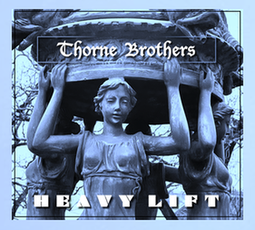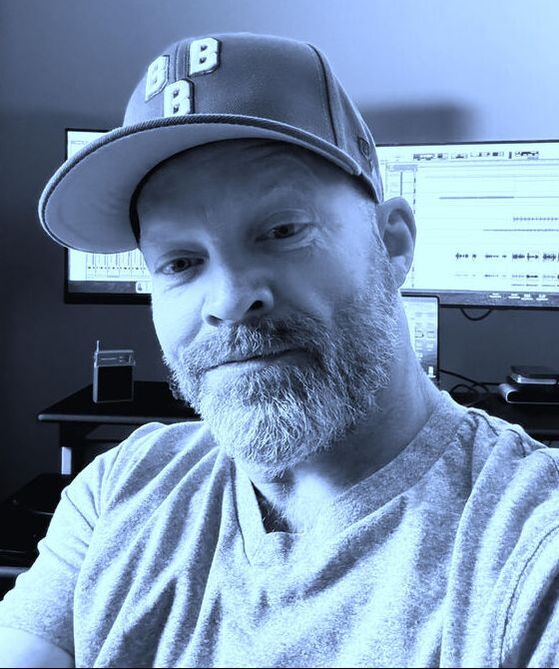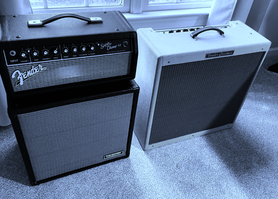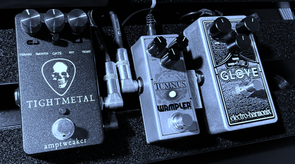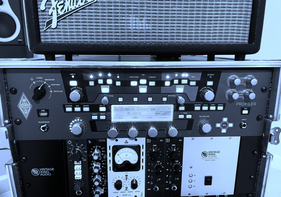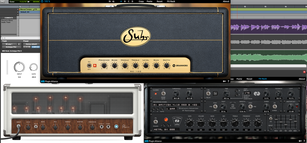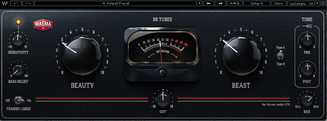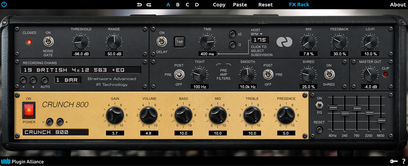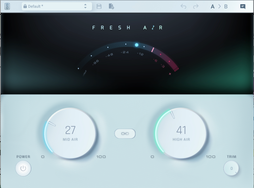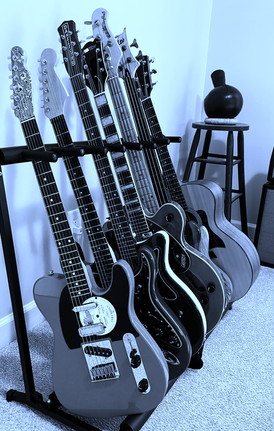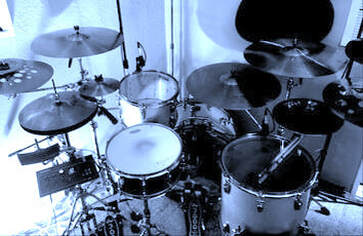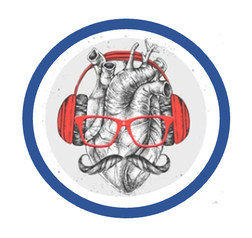The Audio Nerd Log
|
In truth I’m just a supercilious hobbyist playing make-believe in the spare bedroom I call my studio rather than through video games like normal middle-aged men. This page reveals my niggling level of geek-a-tude but hopefully also provides some technical insight on how we made this project in the off chance you’d like to learn from my mistakes.
Guitar is to rock what the 808 is to Hip Hop, center of the plate and often the side dish as well, crowding out any chance of instrumentation subtlety. It is the nature of the genre so we just went with it. Describing guitar tone can sound every bit as pretentious as a sommelier internet troll debate "with notes of nutmeg and gym socks" and as divisive as a Dome of the Rock souvenir stand. I worked in a guitar shop back in the day, so I wasn’t coming into this completely agnostic. However early in the writing process I again consulted the YouTube guitar shaman to figure out what path I should take. With each as contradictory as instagram diet advise I had to cobble together what I could make work for me in my dabbler's environment and skills. Ready to judge me like a bonafide YouTube oracle of audio? |
Taking a page (more like several chapters worth) from the Foo Fighters, stacking guitars for that wall-O’-guitars sound has more nuance than one might think at first blush. Like a layer cake or exposed rock formations in the desert the varying densities of tones provide texture and dimension. That sound is more than just the old school same part same amp just doubled left and right. I have no idea how they actually did it but I chose different guitar and amp combinations to highlight different frequencies. Some of which didn’t sound all that amazing by themselves but in context provided the depth I was looking for, something hollow opposite something woofy, something a bit brittle with something darker. This album has a bit of every conceivable option I could think of in pursuit of a meaty (or alt-meat substitute) stew of guitars.
When in doubt add more Guitar?
The basic road map tracks were recorded using my actual physical amps and pedals. While not the prototypical amps used in this style many of those tracks survived to the final mix. With the benefit of hindsight I probably would have started with virtual amps for writing and then gone back and re-amped for tone later. My process is to continuously iterate on everything even though sometimes I arrive where I started. However that also means for most parts I can no longer tell you exactly what gear was use on any individual part.
|
Conventional tube amps:
59 Reissue Fender 4x10 Bassman, and a Champ X2 with a 12” vintage 30 cab with these mics.
Main pedals:
Feeling I just wasn’t getting a modern enough sound coupled with the need to record direct for volume reasons I went down the new age religion rabbit hole of virtual amps. I bought and recorded several tracks with each of the following before eventually selling them all again for one reason or another.
Hardware modeling
With mixed results I went back to my amps before truly giving software amps a fair shake. For what it’s worth, I found them to be as credible as any of the hardware units at fraction of the price. Software modeling
|
Lessons learned & take-a-ways
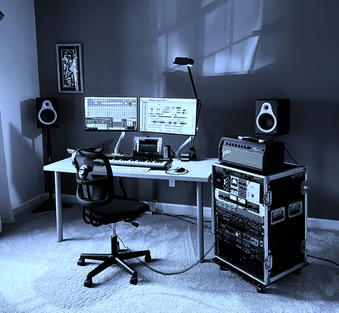
- Humility: Have you ever met someone several times over a span of weeks and still can't remember their name? It has been so long that even asking other people in the group would imply you're a jackass? no? that's just me? okay, well the point is pride becomes the issue. The only way forward is to admit you suck, own the embarrassment of it so you can begin to improve the situation and relationship. Well, same for mixing. “It is impossible for a man to learn what he thinks he already knows.” — Epictetus. Admit what you don't know or isn't working, flush your pride and go back to learn whatever basic skills you missed or skipped along the way and submit to learning them no matter how long you have been doing this or think you have accomplished.
- An accurate environment: Do you see anything wrong with the picture of my room in the photo on the right? Elitist interface √ pretentiously cool mic pres √ absurdly priced optical compressors √ dual screens √ monitors, maybe too close to the wall, but √ acoustic treatments? ... cue the sad trombones. For the gear sluts among us accumulating stuff or even plug-ins always feels more fulfilling. However establishing a proper listening environment is something I wish I understood better a long time ago. When folks say "it isn't about the gear" they are also saying it doesn't matter what you have or frankly what skills you possess if you can't hear it accurately. Please learn from my shortsightedness and figure out how to have an environment where you can hear correctly as priority #1. Largely because the sound of my room was so bad I started mixing this on my Sony MDR-7506 headphones but as practical as they are, still maybe not the best choice for mixing. I tried several different virtual studio plug-ins that supposedly emulate famous mixing rooms but that rendered inconstant results and a less than enjoyable experience.
- Euthanize the superfluous.: I claimed victory over this one a few projects back now but that was a lie. I wasted so much time trying to make tiny parts fit in the mix that actually made zero difference to the emotion or sonic image. Things that are so low in the mix that they add nothing typically still have the power to steel clarity and impact from other elements you have already accepted add more value to your mix goals. Make the tough choice to kill that 9th guitar part that you spent days on. It doesn't matter, no one will care. It's not a goldfish.
- Reference tracks: You must have heard this 100 times as well but I never bothered before and I really should have. It doesn't need to be a complicated thing. Just pull a similar genre song you admire into your session and refer back to it for over all dynamics and frequency center. Be sure to not let it go through your same master bus processing. Your ears will adjust quickly and deceive you. This can serve as a simple truth teller.
- Re-amping: As I eluded to above, especially if you are recording yourself going direct with a software amp makes a lot of sense. That way you can focus on just coming up with the parts and not have to split your thoughts on the technical of tone and waist valuable "in the zone" time on mic placement etc. Then come back once more when the song is fleshed out and dial in a re-amped tone that best fits the song that has developed.
- Saturation: This topic is all over the forums and I don't claim to have any unique insights from the rest of the global punters, but it should be noted that you can quickly over do it. Each plugin typical focuses on slightly different frequencies. My best results came from relatively small amounts of saturation from a few different tools.
The top new and notable plugins for me on this project
Jake Thorne's recording details
|
All of my tracks were recorded in my North Carolina home studio using the following signal chains.
|
Will Thorne's recording details
All of Will's lead and backing vocals were recorded at his Arizona home studio with the following signal chain.
- Shure SM-7B, with a Cloudlifter, Shadow Hills Mono GAMA 500 Series Mic Preamp, IGS Audio ONE LA 500 Tube Optical Compressor Module
into an Audient iD14. in to Pro Tools.
Trey Sabatelli's recording details
|
All of Trey's tracks were recorded at his California home studio using the following.
|
Project flow
If you are thinking of doing your own project, start with #8 first.
- I go to my project starter folder of half baked song ideas and see what inspires me to want to waste 12-36 months on a particular genre
- I make a starter play list and share it with Will and see if he is interested in the space / we talk about suitable causes / aesthetic approaches and topics
- Then I build a pool of song ideas to choose from, sometimes full songs, sometimes just a grove & riff. The goals is to create more than double the number I think we are going to land on. The more you make the better the odds of catching a good one. For this project we had about 24 songs to choose from before we started cutting them down. Some didn't get cut until well after we asked Trey to track them. (sorry dude)
- At some point life usually interrupts us with storms, personal or professional complications and the like. Sometimes more than once. So we just wait them out, the tide eventually reseeds and we start building the sand castle over again. There are also technical setbacks. I had some drives go bad where we lost months of tracking. I had forced upgrades that broke everything in my system. The point is all that stuff is going to happen. If you have something you are doing as your release, wait out the storms but do keep going.
- You find your limits and you work through them as best you can. I get stuck on the mixing phase. I don't know if I'm not good at it because I don't like it or I don't like it because I'm not good at it. Either way I just have to work through it.
- Then you get it mastered or you do it yourself. I choose to use someone else simply because by this point I'm no longer objective.
- Then you find some organized crime family to distribute your project online so your friends and family can listen, for free, but they won't listen anyway.
- Then you come to the real questions. Why did you do this project in the first place? What is your expectation? What are you willing to do to see it realized?
It does appear that in todays market "artists" need to spend the majority of their time on self promotion, on social media, saying "look at me" 24/7 with more discipline and sustained pressure than a Jehovah witness debt collector. Will and I decided, we don't have that in us. Of course we would love to find some number of people who like our music and to know that some important conversations and maybe even participation was inspired by these projects. But regardless of any outside factors we just do it because we are creatives, that is in us.
Thorne Brothers |
Copyright © 2024
